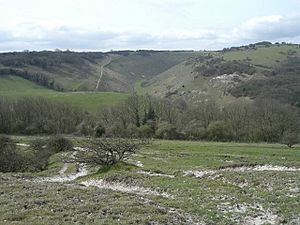Beeding Hill to Newtimber Hill facts for kids
| Site of Special Scientific Interest | |
 |
|
| Area of Search | West Sussex |
|---|---|
| Interest | Biological Geological |
| Area | 321.0 hectares (793 acres) |
| Notification | 1986 |
| Location map | [TQ 250 112 Magic Map] |
Beeding Hill to Newtimber Hill is a very special natural area in West Sussex, England. It covers about 321 hectares (790 acres) of land. This area is important for both its amazing plants and animals (biological) and its interesting rocks and landforms (geological).
Because it's so unique, it's been named a Site of Special Scientific Interest (SSSI). This means it's legally protected to keep its natural features safe. It's also recognized as a top-tier "Nature Conservation Review" site and includes a "Geological Conservation Review" site called Devil's Dyke.
Contents
What Makes This Place Special?
Amazing Grasslands
Most of Beeding Hill to Newtimber Hill is covered in "unimproved chalk grassland." This means the land hasn't been plowed or treated with chemicals. It's very natural.
This type of grassland grows on the slopes of the South Downs. It's home to a huge variety of plants. You can find about 40 different types of flowering plants in just one square meter!
Tiny Creatures with Big Importance
This special grassland is also a fantastic home for many small animals. These are called invertebrates, which means they don't have a backbone.
One important group found here are harvestmen. These spider-like creatures are very important to the area's ecosystem. The collection of harvestmen here is considered nationally important.
The Story of Devil's Dyke
Devil's Dyke is a famous part of this area. It's very important for understanding geology, which is the study of Earth's physical structure and history.
Devil's Dyke is a great example of how the land was shaped long ago. During the Pleistocene era, which was an ice age, water and ice carved out this "dry chalk valley." It shows us how powerful nature can be in changing the landscape over thousands of years.
Images for kids







